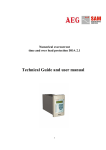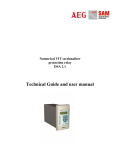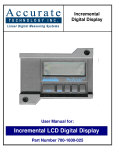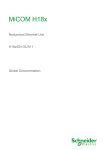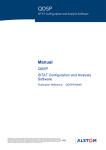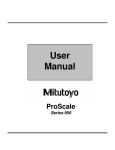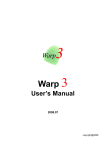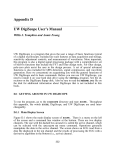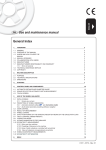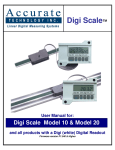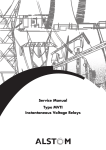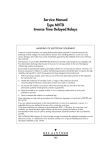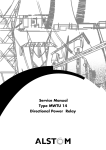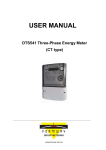Download Technical Guide and user manual
Transcript
DOA 0.1 Numerical Sensitive Over Current Protection Relay Technical Guide and user manual 1 Technical Guide and user manual Contents DOA 0.1 NUMERICAL SENSITIVE OVER CURRENT CONTENTS Introduction Handling, Installation and Case Dimensions User Guide Menu Content Tables Technical Data and Curve Characteristics Application Guide 2 Introduction DOA 0.1 CONTENTS 1. INTRODUCTION 2 2. HOW TO USE THIS MANUAL 3 3. INTRODUCTION TO THE DOA 0.1 4 4. MAIN FUNCTIONS 5 3 Introduction DOA 0.1 1. INTRODUCTION The sensitive over current relay type DOA 0.1is a numerical relay. It is over current and sensitive earth fault relay that you can configure it separately that means you have three phase over current and sensitive earth fault that zone of sensitive is from 0.002In to In. 4 Introduction DOA 0.1 2. HOW TO USE THIS MANUAL This manual provides a description of DOA 0.1functions and settings. The goal of this manual is to allow the user to become familiar with the application, installation, setting and commissioning of the relay. This manual has the following format: DOA 0.1 Introduction Contents of the manual and general introduction to the relay DOA 0.1 Handling, installation and case dimensions Precautions to be taken when handling electronic equipment. DOA 0.1 User Guide of the relay as A detailed description of the features DOA 0.1 Technical data and Comprehensive details on nominal values, setting ranges, specifications. DOA 0.1 Commissioning and Maintenance Guide Guide to commissioning, problem solving and maintenance of Do A 0.1 DOA 0.1 Connection diagrams for the relay DOA 0.1 Commissioning test records DOA 0.1 Hardware/Software version history 5 Introduction DOA 0.1 DOA 0.1 Communication mapping data bases 3. INTRODUCTION TO THE DOA 0.1 RELAY The DOA 0.1 relay provide comprehensive Voltage fault protection for utilities networks, industrial plants and networks as well as for other applications where Voltage protection is required. In addition to its protective functions, each relay offers control and recording features. They can be fully integrated to a control system so protection, control, data acquisition and recording of faults, events and disturbances can be made available. The relay is equipped on the front panel with a liquid crystal display (LCD) with 2 x 16 back-lit alphanumerical characters, a tactile 7 button keypad (to access all settings, clear alarms and read measurements) and 11 LEDs that indicate the status of the relay. In addition, the use of the RS485 communication port by using protocol mode bus makes it possible to read, reinitialize and change the settings of the relay, if required, from a local or remote PC computer loaded with software. Its flexibility of use, reduced maintenance requirements and ease of integration allow the Relay to provide an adaptable solution for the problems of the protection electric networks. 6 Introduction DOA 0.1 4. MAIN FUNCTIONS The following table shows the functions available for DoA 0.1relay. Functions ANSI Code DOA 2.1 one-phase overcurrent 50/51 yes Instantaneous/start contact yes Instantaneous/start contact yes Latching output contacts 86 yes Setting groups 2 Blocking logic yes Measurements (True RMS) yes RS 232 front communication yes Fault Record , Event Record yes RS 485 rear communication (Modbus RTU) yes 7 Introduction DOA 0.1 GENERAL FUNCTIONS 1 Digital inputs 2 2 Output relays 4 3 Remote communication (RS485 port) • 4 Local communication (RS232 port) • 5 Event recording 75 6 Fault recording 5 7 Disturbance recording 5 8 Setting group 2 8 Handling, Installation and Case Dimensions DOA 0.1 HANDLING, INSTALLATION AND CASE DIMENSIONS 9 Handling, Installation and Case Dimensions DOA 0.1 CONTENTS 1. GENERAL CONSIDERATIONS 2 1.1 Receipt of relays 2 1.2 Electrostatic discharge (ESD) 2 2. HANDLING OF ELECTRONIC EQUIPMENT 3 3. RELAY MOUNTING 4 4. UNPACKING 5 5. STORAGE 6 6. DIMENSIONS 7 7. Communication 8 7.1 RS232 Port 8 7.2 RS485 Port 8 8. Earthing 8 10 Handling, Installation and Case Dimensions DOA 0.1 1. GENERAL CONSIDERATIONS 1.1 Receipt of relay Protective relay, although generally of robust construction, require careful treatment prior to installation on site. Upon receipt, relay should be examined immediately to ensure no damage has been sustained in transit. If damage has been sustained during transit a claim should be made to the transport contractor and AEG SAM should be promptly notified. 1.2 Electrostatic discharge (ESD) The relay use components that is sensitive to electrostatic discharges. The electronic circuits are well protected by the metal case and the internal module should not be withdrawn unnecessarily. When handling the module outside its case, care should be taken to avoid contact with components and electrical connections. If removed from the case for storage, the module should be placed in an electrically conducting antistatic bag. There are no setting adjustments within the module and it is advised that it is not unnecessarily disassembled. Although the printed circuit boards are plugged together, the connectors are a manufacturing aid and not intended for frequent dismantling; in fact considerable effort may be required to separate them. Touching the printed circuit board should be avoided, since complementary metal oxide semiconductors (CMOS) are used, which can be damaged by static electricity discharged from the body. 11 Handling, Installation and Case Dimensions DOA 0.1 2. HANDLING OF ELECTRONIC EQUIPMENT A person’s normal movements can easily generate electrostatic potentials of several thousand volts. Discharge of these voltages into semiconductor devices when handling electronic circuits can cause serious damage, which often may not be immediately apparent but the reliability of the circuit will have been reduced. The electronic circuits are completely safe from electrostatic discharge when housed in the case. Do not expose them to risk of damage by withdrawing modules unnecessarily. Each module incorporates the highest practicable protection for its semiconductor devices. However, if it becomes necessary to withdraw a module, the following precautions should be taken to preserve the high reliability and long life for which the equipment has been designed and manufactured. 1. Before removing a module, ensure that you are at the same electrostatic potential as the equipment by touching the case. 2. Handle the module by its front plate, frame or edges of the printed circuit board. Avoid touching the electronic components, printed circuit track or connectors. 3. Do not pass the module to another person without first ensuring you are both at the same electrostatic potential. Shaking hands achieves equal potential. 4. Place the module on an antistatic surface, or on a conducting surface which is at the same potential as yourself. 5. Store or transport the module in a conductive bag. If you are making measurements on the internal electronic circuitry of an equipment in service, it is preferable that you are earthed to the case with a conductive wrist strap. Wrist straps should have a resistance to ground between 500kΩ – 10MΩ. If a wrist strap is not available you should maintain regular contact with the case to 12 Handling, Installation and Case Dimensions DOA 0.1 prevent a build-up of static. Instrumentation which may be used for making measurements should be earthed to the case whenever possible. More information on safe working procedures for all electronic equipment can be found in BS5783 and IEC147. It is strongly recommended that detailed investigations on electronic circuitry or modification work should be carried out in a special handling area such as described in the above-mentioned BS and IEC documents. 3. RELAY MOUNTING The relay is dispatched either individually or as part of a panel/rack assembly. Modules should remain protected by their metal case during assembly into a panel or rack. For individually mounted relays an outline diagram is supplied in following of this chapter showing the panel cut-outs and hole centers. 13 Handling, Installation and Case Dimensions DOA 0.1 4. UNPACKING Care must be taken when unpacking and installing the relay so that none of the parts is damaged or the settings altered. The relay must only be handled by skilled personnel. The installation should be clean, dry and reasonably free from dust and excessive vibration. The site should be well lit to facilitate inspection. The relay that has been removed from the case should not be left in a situation where that is exposed to dust or damp. This particularly applies to installation which is being carried out at the same time as construction work. 14 Handling, Installation and Case Dimensions DOA 0.1 5. STORAGE If relay is not to be installed immediately upon receipt they should be stored in a place free from dust and moisture in their original cartons. Where de-humidifier bags have been included in the packing they should be retained. The action of the de-humidifier crystals will be impaired if the bag has been exposed to ambient conditions and may be restored by gently heating the bag for about an hour, prior to replacing it in the carton. Dust which collects on a carton may, on subsequent unpacking, find its way into the relay; in damp conditions the carton and packing may become impregnated with moisture and the de-humidifier will lose its efficiency. Storage temperature: –25°C to +70°C. 15 Handling, Installation and Case Dimensions DOA 0.1 6. CASE DIMENSIONS The relay is available in a 4U metal case for panel or flush mounting. Weight: 1.8 Kg Front panel 177 mm Front panel 103 mm Front panel + case 252 mm External size: Height case 152 mm Width case 97 mm Depth case 226 mm 102.4 16 Handling, Installation and Case Dimensions DOA 0.1 7. Communication 7.1 RS232 Port In the bottom of the front panel, there is a RS232 port; the communication with a computer through the RS232 allows access to the relay all information and setting. It makes the access and changes of any information, setting and configuration. You can see all events and records by this port on monitor of computer we will explain it by details in the next sections. 7.2 RS485 port Connections to RS485 are made using annular terminals. It is recommended that a two core screened cable, is used with a maximum total length of 1000 m or a200nF total cable capacitance. Typical specification: − Each core: 16/0.2 mm copper conductor, PVC insulated. − Nominal conductor area: 0.5 mm² per core − Screen: Overall braid, PVC sheathed − Linear capacitance between conductor and earth: 100pF/m 8. Earthing Each equipment must be connected to a local earth terminal by the intermediary of a M4 earth terminal. We recommend a wire of minimal section of 2,5 mm², with annular terminals on the side of the equipment. Because of the limitations of the annular terminals, the possible maximum section is of 6mm² by wire. If a larger section is necessary, one can use cables connected in parallel, each one ending with an annular terminal separated on the side of the equipment. One can also use a metal bar. NOTE: To prevent any electrolytic risk between copper conductor or brass conductor and the back plate of the equipment, it is necessary to take precautions to isolate them one from the other. This can be done in several ways, for example by inserting between the conductor and the case a plated nickel or insulated ring washer or by using a tin terminals. 17 User Guide DOA 0.1 User Guide 18 User Guide DOA 2.1 CONTENTS 1. PRESENTATION OF DOA 0.1 RELAY 2 2. USER INTERFACE 3 4 2.1 LCD display and keypad description 4 2.1.1 LCD display 2.1.2 Keypad 4 2.2 LEDs 5 2.3 Description of the two areas under the top and bottom flaps 6 3. PASSWORD 7 3.1 Password protection 7 3.1.1 Password entry 7 3.1.2 Changing the password 7 3.1.3 Change of setting invalidation 8 4. DISPLAYS OF ALARM & WARNING MESSAGES 8 4.1 Electrical Network Alarms 8 4.2 Relay Hardware or Software Warning Messages 10 19 User Guide DOA 2.1 1. PRESENTATION OF DOA 0.1 RELAY This relay is fully numerical relays designed to perform electrical protection and control functions. DoA 0.1 relay is powered either from a DC or an AC auxiliary power supply. Using the front panel, the user can easily navigate through the menu and access data, change settings, read measurements, etc. Eleven LEDs situated in the front panel help the user to quickly know the status of the relay and the presence of alarms. Alarms that have been detected are stored and can be displayed on the back-lit LCD. Any short time voltage interruption (<50ms) is filtered and regulated through the auxiliary power supply. DoA 0.1 relay have 3 phase inputs available for 1 and 5 Amps rated CTs. On each one of these relay. DoA 0.1 relay continuously measure phase and earth currents and take into account the true RMS current value up to 10th harmonic (at 50 Hz). Output relays are freely configurable and can be activated by any of the control or protection functions available in the relay. Logic inputs can also be assigned to various control functions. On their rear terminals DoA 0.1 have a standard RS485 port available. When ordering, the user can choose between the following communication protocols: Modbus RTU. Using RS485 communication channel, all stored information (measurements, alarms, and parameters) can be read and settings can be modified when the chosen protocol allows it. DoA 0.1 relay can be connected directly to a digital control system. All the available data can then be gathered by a substation control system and be processed either locally or remotely. 20 User Guide DOA 2.1 2. USER INTERFACE DoA 0.1 relay from panel allows the user to easily enter relay settings, display measured values and alarm and to clearly display the status of the relay. 2 × 16 alphanumerical backlit display 2 buttons to read and clear alarms messages Trip led Alarm led Warning led Programmable leds 5 buttons to modify the setting and read vaues Battery RS 232 FIGURE 1: DOA 0.1 front panel The front panel of the relay has three separate sections: 1. The LCD display and the keypad, 2. The LEDs 3. The two zones under the upper and lower flaps 21 User Guide DOA 2.1 2.1 LCD display and keypad description 2.1.1 LCD display In the front panel, a liquid crystal display (LCD) displays settings, measured values and alarms. Data is accessed through a menu structure. The LCD has two lines, with sixteen characters each. A back-light is activated when a key is pressed and will remain lit for five minutes after the last key press. This allows the user to be able to read the display in most lighting conditions. 2.1.2 Keypad The keypad has seven keys divided into two groups: Two keys located just under the screen (keys and ). Keys and are used to read and acknowledge alarms. To display successive alarms, Press key . Alarms are displayed in reverse order of their detection (the most recent alarm first, the oldest alarm last). To acknowledge the alarms, the user can either acknowledge each alarm using or go to the end of the ALARM menu and acknowledge all the alarms at the same time. When navigating through submenus, key is also used to come back to the head line of the corresponding menu. NOTE: To acknowledge a relay latched refer to the corresponding submenu section. Four main arrow keys located in the middle of the front panel. They are used to navigate through the different menus and submenus and to do the setting of the relay. The enter key is used to validate a choice or a value (modification of settings). 22 User Guide DOA 2.1 2.2 LEDs The top three LEDs indicate the status of the relay (Trip condition, alarm LED, equipment failure). The five lower LEDs are freely programmable by the user and can be assigned to display a threshold crossing for example (available for all models) or to show the status of the logic inputs .The description of each one of these eight LEDs located in the left side of the front view is given hereafter (numbered from the top to bottom from 1 to 3), 3 LEDs at bottom showed by G1 , G2 , auxiliary supply. LED 1 Color: RED Label: Trip LED 1 indicates that the relay has issued a trip order to the cut-off element (circuit breaker, contactor). This LED recopies the trip order issued to the Trip logic output. As soon as a triggering order is issued, the LED lights up. It is cleared when the associated alarm is acknowledged either through the front panel, or by a remote command, a digital input, or by a new fault (configuration/Alarms menu). LED 2 Color: yellow Label: ALARM LED 2 indicates that the relay has detected an alarm. This alarm can either be a threshold crossing (instantaneous), or a trip order (time delayed). As soon as an alarm is detected, the LED starts blinking. After all the alarms have been read, the LED lights up continuously. After acknowledgement of all the alarms, the LED is extinguished. The alarm LED can be reset either through the front panel, or by remote command, by a digital input, or by a new fault. LED 3 Color: YELLOW Label: Warning LED 3 indicates internal alarms of the relay. When the relay detects a « non critical » internal alarm (typically a communication failure), the LED starts blinking continuously. When the relay detects a fault that is considered as « critical », the LED lights up continuously. Only the disappearance of the cause of the fault can clear this LED (repair of the module, clearance of the Fault). LED G1: this LED indicates that group1 adjustment is active LED G2: this LED indicates that group2 adjustment is active LED power: this LED indicates that power is alive on. 23 User Guide DOA 2.1 2.3 Description of the two areas under the top and bottom flaps There is RS232 port available in the relay. This RS232 port can be used either to download a new version of the application software version into the relay flash memory or to plug a laptop loaded with setting software. To withdraw more easily the active part of the relay (i-e the chassis) from its case, open the two flaps, then with a 3mm screwdriver, turn the extractor located under the upper flap, and pulls it out of its case pulling the flaps towards you. 24 User Guide DOA 2.1 3. PASSWORD 3.1 Password protection An unlock key (up down) is required, when you want to press any key. After 5 minutes that you don’t press any key, you must unlock the keys for navigation through menus. A password is required for relay settings, especially when changing the various thresholds, time delays, communication parameters, allocation of inputs and outputs relays. The password consists of four capital characters. When leaving factory, the password is set to AAAA. The user can define his own combination of four characters. Should the password be lost or forgotten, the modification of the stored parameters is blocked. It is then necessary to contact the manufacturer or his representative and a standby password specific to the relay may be obtained. The programming mode is indicated with the letter "P" on the right hand side of the display on each menu heading. The letter "P" remains present as long as the password is active (5 minutes if there is no action on the keypad). 3.1.1 Password entry The input of the password is requested as soon as a modification of a parameter is made for any one of the six/eight menus and the submenus. The user enters each one of the 4 characters and then validates the entire password with enter keypad. After 5 seconds, the display returns to the point of the preceding menu. If no key is pressed inside of 5 minutes, the password is deactivated. A new password request is associated with any subsequent parameter modification. 3.1.2 Changing the password To change an active password, go to the OP. PARAMETERS menu and then to the Password submenu. Enter the current password and validate it. Then press enter keypad and enter the new password character by character and validate the new password using enter keypad. The message NEW PASSWORD OK is displayed to indicate that the new password has been accepted. 25 User Guide DOA 2.1 3.1.3 Change of setting invalidation The procedure to modify a setting is described in the following sections of this manual. If there is a need to get back to the old setting push key before validating the setting change. The following message will then appear on the LCD for a few seconds and the old setting will remain unchanged. UPGRADE CANCEL 4. DISPLAYS OF ALARM & WARNING MESSAGES Alarm messages are displayed directly on the front panel LCD. They have priority over the default display presenting measured current values. As soon as the relay detects an alarm condition (crossing of a threshold for example), the associated message is displayed on the front panel LCD and the LED Alarm (LED 2) lights up. We distinguish two types of alarm and warning messages : - Alarm messages generated by the electrical power network. - Warning messages caused by hardware or software faults from the relay. 4.1 Electrical Network Alarms Any crossing of a threshold (instantaneous or time delay) generates an "electrical network alarm". The involved threshold is indicated. Regarding the phase thresholds, the phase designation (A, B or C) is also displayed. If several alarms are triggered, they are all stored in their order of appearance and presented on the LCD in reverse order of their detection (the most recent alarm first, the oldest alarm last). Each alarm message is numbered and the total number of alarm messages is displayed. The user can read all the alarm messages pressing. The user acknowledges and clears the alarm messages from the LCD pressing. The user can acknowledge each alarm message one by one or all by going to the end of the list to acknowledge, and clear, all the alarm messages pressing. The control of the ALARM LED (LED 2) is directly assigned to the status of the alarm messages stored in the memory. If one or several messages are NOT READ and NOT ACKNOWLEDGED, the ALARM LED (LED 2) flashes. If all the messages have been READ but NOT ACKNOWLEDGED, the ALARM LED (LED 2) lights up continuously. If all the messages have been ACKNOWLEDGED, and cleared, if the cause that generated the alarm disappears, the ALARM LED (LED 2) is extinguished. 26 User Guide DOA 2.1 4.2 Relay Hardware or Software Warning Messages Any software or hardware fault internal to DoA 0.1 relay generates a "hardware/software alarm" that is stored in memory as a "Hardware Alarm". If several hardware alarms are detected they are all stored in their order of appearance. The warning messages are resented on the LCD in reverse order of their detection (the most recent first and the oldest last). Each warning message is numbered and the total stored is shown. The user can read all warning messages pressing, without entering the password. It is not possible to acknowledge and clear warning messages caused by internal relay hardware or software failure. This message can only be cleared once the cause of the hardware or software failure has been removed. The control of the WARNING LED (LED 3) is directly assigned to the status of the warning messages stored in the memory. If the internal hardware or software failure is major (i.e. the relay cannot perform protection functions), the WARNING LED (LED 3) lights up continuously. If the internal hardware or software failure is minor (like a communication failure that has no influence on the protection and automation functions), the WARNING LED (LED 3) will flash. Possible Hardware or Software alarm messages are: Major fault: The protection and automation functions are stopped. The RL0 watchdog relay is de-energized (35-36 contact closed). <<EEPROM ERROR CALIBR. >>: Calibration zone failure <<CT ERROR>>: Analog channel failure Minor fault: The DoA 0.1 relay is fully operational. The RL0 watchdog relay is energized (35-36 contact open, 36-37 contact closed). <<RAM ERROR>>: RAM supplied by battery failed. <<Battery fail>>: battery failure (flat or not correctly in place 27 User Guide DOA 2.1 NOTE: The <<Battery backed RAM memory>> and <<Battery failure>> alarm Messages can be configured to be displayed or not by selecting yes or no, in the configuration/Alarms menu. << DEFAULT SETTINGS (*) >> << SETTING ERROR (**) >> <<COMM.ERROR>>: Communication failure <<CLOCK ERROR>>: Time tag failure (*) DEFAULT SETTINGS: Each time the relay is powered ON it will check its memory contents to determine whether the settings are set to the factory defaults. If the relay detects that the default settings are loaded an alarm is raised. The ALARM LED (YELLOW) will light up and the Watch Dog contact will be activated. Only one parameter in the relay's menu needs to be changed to suppress these messages and to reset the watch dog. This alarm is only an indication to the user that the relay has its default settings applied. (**) SETTING ERROR: Should the CPU fails to get correctly store data to the EEPROM during a setting change, a "HARDWARE" ALARM will appear on the LCD display followed by "SETTING ERROR" message (when pushing on the button). In addition, the ALARM LED (YELLOW) will light up and the Watch Dog contact will be activated to reset this alarm it is necessary to power ON and OFF the relay. Following this, the last unsuccessful setting change will then need to be re-applied. If the alarm persists, i.e. the "SETTING ERROR" alarm is still displayed, please contacts AEG Sam after Sales Services for advice and assistance. 28 User Guide DOA 2.1 5. MENUS The menu of DoA 0.1 relay is divided into main menus and submenus. The available content depends on the model of the relay. 5.1 Default display By default, the LCD displays the current value measured (selected phase or earth). As soon as an alarm is detected by the relay, that information is considered as more important and the alarm message is then displayed instead of the default value. The user can configure the information he wants to display by default going under the CONFIGURATION/Display menu. 5.2 Access to the menu Navigation through the different menus is done pressing the arrow keys . The organization of the menus is shown in figure as follows. There is need of an unlock key when reading parameters and measured values. Modification of a parameter requires entering a password. Should an error be made in entering a parameter, press to cancel? NOTE: The letter P is displayed when the password needs to be entered. If no key is pushed during 5 minutes, the password needs to be entered again. 5.3 Menu contents description The menu of DoA 0.1 relay is divided into 8 main sections OP PARAMETERS CONFIGURATION MEASUREMENTS COMMUNICATION PROTECTION G(1) PROTECTION G2 AUTOMAT. CTRL RECORDS To access these menus from the default display press. 29 30 31 32 33 34 35 36 37 38 39 40 41 42 43 44 45 46 47 48 49 50 51 32 34 36 38 40 42 44 46 48 50 52 54 56 31 33 35 37 39 41 43 45 47 49 51 53 55 1 3 5 7 9 11 13 15 17 19 21 23 25 27 2 4 6 8 10 12 14 16 18 20 22 24 26 28 A B C Long terminals Pins terminals Ipcb type (c) (d) Vx = 48 - 150 Vdc or 35 - 110 V ac (2) Earth terminals are typical only Short terminals break before(c) CT Shorting links make befor (b) and (c) disconnect (b) 1 (a) Nota: 30 29 Phase rotation W Module terminal blocks viewed from rear with integral case earth link V U programmable input2 programmable input1 1A 5A AUxiliary voltage 1 27 1 IN2 2 23 25 IN1 2 21 56 55 48 47 34 33 K K A A E E C C 3 4 3 4 * 32 31 30 29 9 7 15 13 19 17 3 1 11 5 end of the RS485 bus The relay is connected at the * Link terminals 30 and 32 if DOA0.1 RL4 RL3 RL2 RL1 The current inputs are connected to 3 phase CTs Port connection RS485 Case earth connection programmable output programmable output programmable output Tripping output




















































